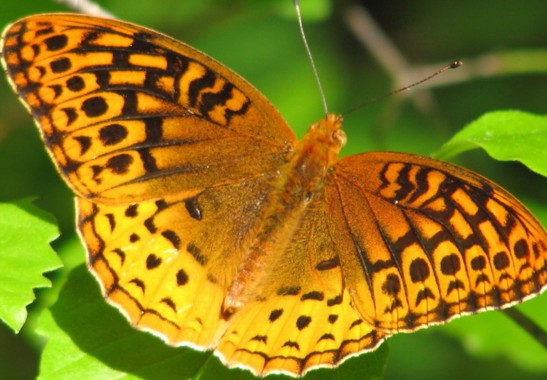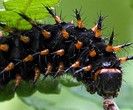 The great spangled fritillary inhabits moist meadows , pastures, prairies, and woodlands all over the US except Florida. The common name fritillary comes from the Latin word fritillus meaning chess board or dice box which refers to the checkered black pattern on the orange ground of these butterflies. Viewed from above, the fore wing has five black dashes along its base while the hind wing has several black dashes at its base. An irregular black band lies in the middle of the wings, with a row of black dots and two rows of black crescents along the outer edges. The females tend to be darker have a more smudgy look than the males and western species of both genders are brighter orange than their eastern counterparts. Fritillarias are often difficult to distinguish in the field but this one is the largest of the genus with a wing span of 2.25 to 3.5 inches.
The great spangled fritillary inhabits moist meadows , pastures, prairies, and woodlands all over the US except Florida. The common name fritillary comes from the Latin word fritillus meaning chess board or dice box which refers to the checkered black pattern on the orange ground of these butterflies. Viewed from above, the fore wing has five black dashes along its base while the hind wing has several black dashes at its base. An irregular black band lies in the middle of the wings, with a row of black dots and two rows of black crescents along the outer edges. The females tend to be darker have a more smudgy look than the males and western species of both genders are brighter orange than their eastern counterparts. Fritillarias are often difficult to distinguish in the field but this one is the largest of the genus with a wing span of 2.25 to 3.5 inches.
 Female butterflies mate in June or July and then lay their yellow to tan eggs in August and September near wild violets (Viola spp). Tiny black caterpillars with red based spines emerge in two to three weeks, eat part of their egg shell, seek cover, and are not active until spring. In May when the violets appear they feed on the leaves and flowers at night and hide during the day. Pupation occurs in June and lasts two to three weeks.
Female butterflies mate in June or July and then lay their yellow to tan eggs in August and September near wild violets (Viola spp). Tiny black caterpillars with red based spines emerge in two to three weeks, eat part of their egg shell, seek cover, and are not active until spring. In May when the violets appear they feed on the leaves and flowers at night and hide during the day. Pupation occurs in June and lasts two to three weeks.
In their natural habitat, caterpillars feed on wild violets such as common blue violet (Viola papillionacea), Canada violet, (V. canadensis), sand violet (V. adunca), and round-leaved violet (V. rotundifolia) but cultivated violets are believed to be very satisfactory. The adults like a variety of garden plants and are known for their long nectaring on thistles. Good garden plants that attract adults include purple coneflower (Echinacea purpurea), Joe Pye weed (Eupatorium purpureum), milkweeds (Asclepius spp.), bergamont (Monarda fistulosa), bee balm (Monarda didyma), mountain laurel ( Kalmia latifolia), blanket flower (Gallardia x grandiflora and G. aristata), lantana, verbena, black-eyed susan (Rudbeckia spp), globe thistle (Echinops ritro), and red valerian (Centranthus ruber).